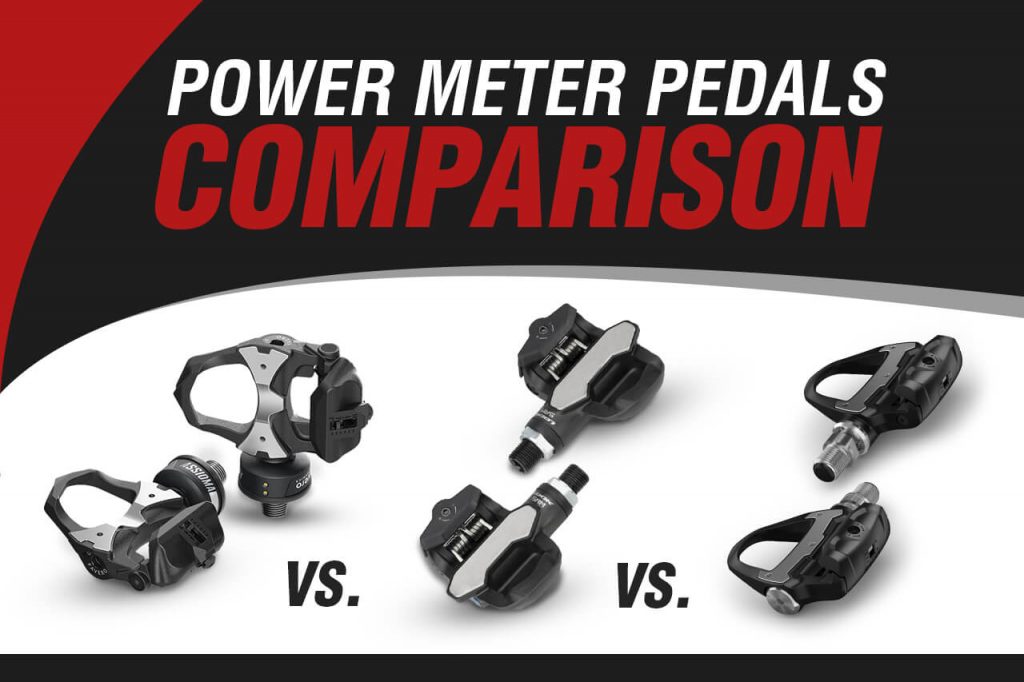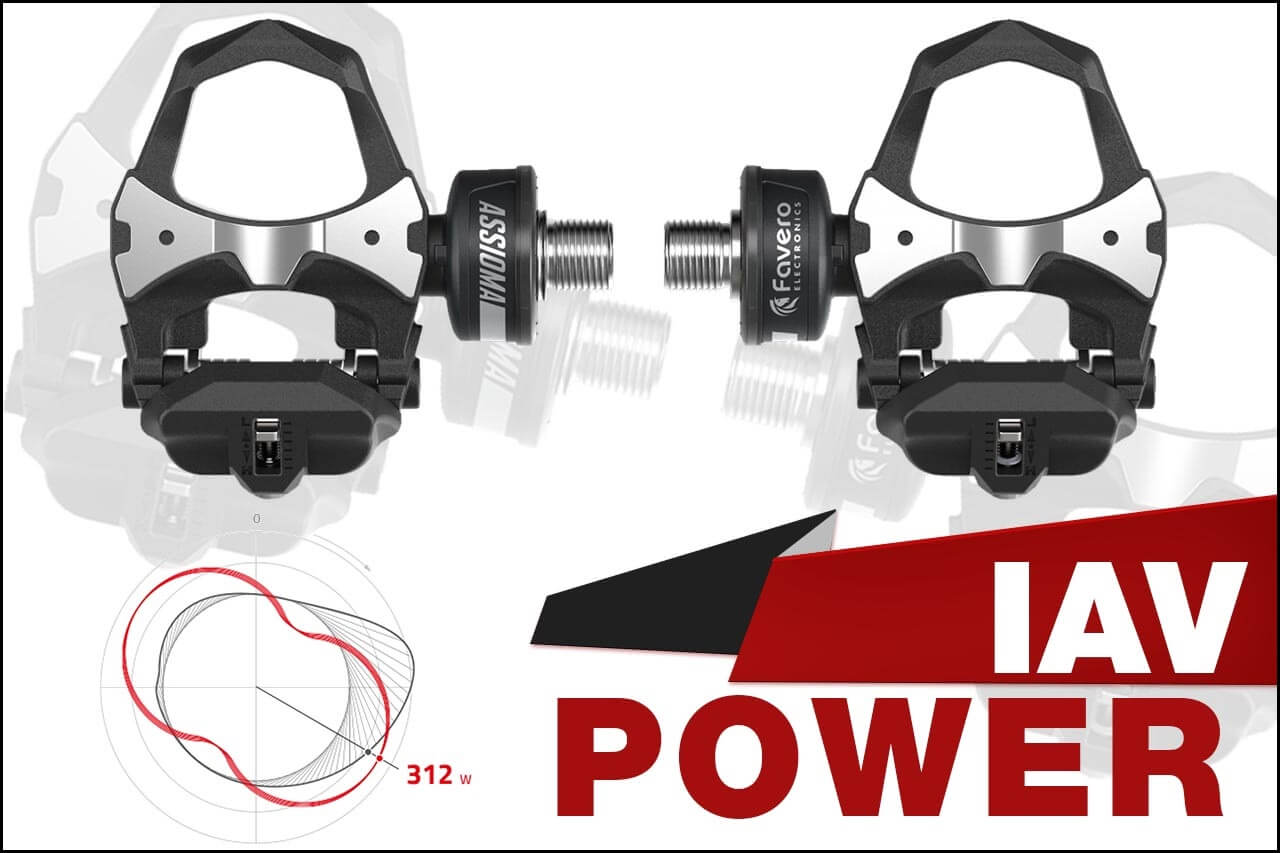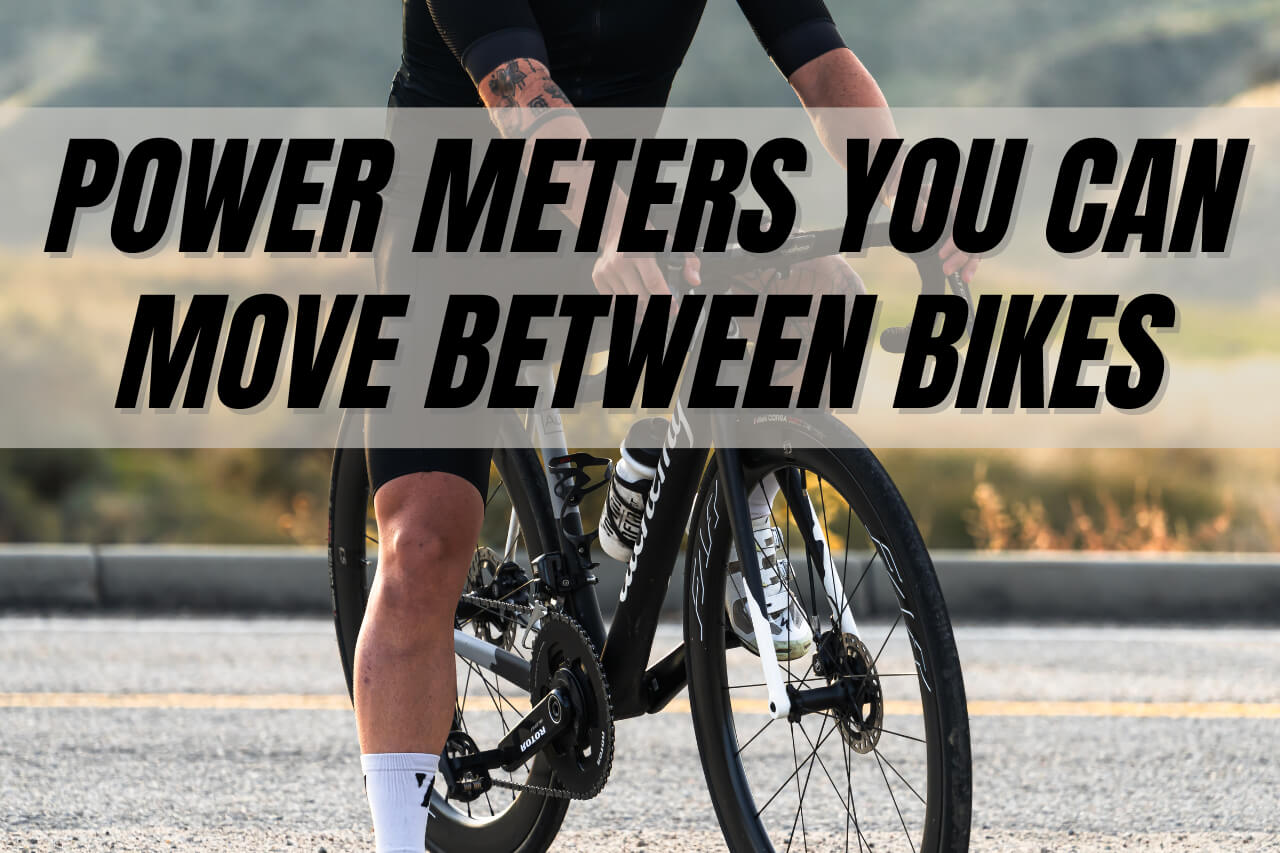While there are several different types of power meters to choose from (with each one having its own unique set of advantages and considerations), pedal-based power meters continue to be one of the most popular and widely used. So, we thought it appropriate if we reviewed your different power meter pedal options. Specifically, we’ll touch on why this type of power meter is so popular, summarize the different pedals by brand and then put them head-to-head in a power meter pedals comparison. Sound good? Let’s check it out!

Why Pedals-Based Power Meters are Popular
Power meter pedals were introduced to the market around 2015. They use strain gauges (the tiny devices that measure power) inside the pedal itself. As previously mentioned, pedals are one of the most popular power meter types. Here are the advantages to using a power meter pedal:
- Power meter pedals are one of the easiest power meters to install. They simply attach to the crank arm – basically like a normal set of pedals. (More on this later.)
- They are compatible with virtually every bike. This is unlike other power meter types where compatibility is often a concern.
- They can be quickly and easily moved from one bike to the next.
- Since the pedals house a power sensor in each pedal, they can measure each leg’s power independently (assuming you opt for a dual-sided model). This is referred to as left vs. right or independent left/right power measurement.
- They are a great indoor power meter option if you are looking to add power to a stationary bike.
Options Abound!
There is another advantage of going with a pedal based power meter…you have options…four to be exact. Or more if you consider the single-sided variants. This increases the likelihood that you can find a set of pedals that fits your needs. Most people know that Garmin and PowerTap make pedals. Garmin makes the Vector 3 while PowerTap makes the P2. However a PowerTap P2 vs Garmin Vector 3 comparison would be short sided. Favero Electronics, based in Italy, makes the Assioma. It’s a terrific pedal, is highly accurate and has a wonderful track record of reliability. As you will see below, it stacks up pretty favorably against the other two heavyweights. In addition, SRM and LOOK have partnered on the EXAKT power meter pedal. The EXAKT is built on a LOOK carbon pedal body, benefits from SRM’s renowned engineering and comes loaded with nifty features.
A Quick Note on Cost…
One more thing before we move on…cost. In general, we would put power meter pedals somewhere in the middle of the power meter cost spectrum – with the exception of the EXAKT which comes at a premium price point. Specifically, a set of dual-sided power meter pedals costs $759 on the low end (Favero Assioma DUO) and $1,299 on the high end (SRM LOOK EXAKT). The PowerTap P2 and Garmin Vector 3 slot in the middle at $899 and $999, respectively. Note that most of these companies offer a single-sided version of their pedal at a lower price.
Ok, so let’s review these power meters in a bit more detail.
Favero Assioma
The Assioma power meter pedals are manufactured by Favero Electronics, an Italian-based company. The Assioima DUO is a dual-sided system and takes power from both legs, whereas the UNO is a left-sided pedal. These power meters measure power up to 2,000 watts and cadence from 30-180 RPM. In addition to being the most affordable dual-sided power meter on the market, the Assioma is also one of the most reliable and consistent power meters we sell. The icing on the cake is the fact that, using Favero’s IAV Power Technology, they are accurate to +/- 1.0%.


Garmin Rally
The Garmin Rally Power Meter is also a dual-sided power meter with sensors in both pedals. Garmin is on its third generation of the pedal (the previous version was called the Vector 2). On the Vector 3, Garmin eliminated the pedal pods, improved installation and added Bluetooth SMART capability, among other improvements. In addition, like the previous generation, the Vector 3 provides access to Garmin’s suite of advanced cycling dynamics data. A single-sided version, the Garmin Vector 3S, is also available.
SRM LOOK EXAKT
The SRM LOOK EXAKT power meter is the latest pedal to hit the scene. Created in a partnership between LOOK and SRM, the EXAKT is built on a LOOK carbon pedal body and features a fully integrated design. The EXAKT also benefits from SRM’s long experience in building power meters and is cited accurate to +/- 1.5%. Available in both dual-sided and single-sided versions, the EXAKT offers all the features you would expect in a modern-day power meter: dual-sided power, ANT+ and Bluetooth SMART compatibility, a rechargeable battery with 100 battery life and built-in magnet for cadence. However, the pedal does come at a premium price point.

Head-to-Head Power Meter Pedals Comparison
Ok, now let’s see how these four brands stack up head-to-head across the key features that are important to power meter users.
Installation
Installation is a three-way tie for the win. The Favero Assioma, Garmin Vector 3 and PowerTap P2 all install like a normal set of pedals. No torque wrench or special tools necessary. Just grab a hex wrench and screw them on. This also makes moving the pedals between bikes a breeze, should that need arise.
The SRM LOOK EXAKT is a bit more work to install. The EXAKT pedals come with a mounting tool, which you use to hold the spindle in place while you tighten down the nut. We should note however that with a bit of practice, you can get them on pretty quickly. In addition, the EXAKT smartphone app has a function whereby you can verify alignment. Most users leave the tool aside and just use the app for guidance – no real worries.
We note that while the Favero Assioma is super quick to install, it does require that you register the pedals with the free Assioma app and ride for a minute or two to set the installation angles – before the pedals will send power and cadence to your head unit. These steps are pretty easy and we have outlined all of the Assioma set-up instructions for you.
Weight
The Assioma is the lightest pedal in this power meter pedals comparison (but just by a hair), weighing in at 149.5 grams per pedal. This compares to the SRM LOOK EXAKT at 155 grams per pedal, the Garmin Vector 3 at 158 grams per pedal and the PowerTap P2 at 199 grams per pedal. The difference here is slight, especially between the Assioma, SRM LOOK and Garmin, but as we all know, grams add up.
Left/Right Power Measurement
Tie
The dual-sided versions of all four power meters contain a power sensor in both the left and right pedal and can therefore measure independent left/right power. As previously stated, the ability to measure left/right power is a major draw to using a pedal-based power meter.
Battery Type
Tie
True these pedals use different batteries, but who are we to tell you which battery is best – which is why we call this a tie. All battery types have their pros and cons so it’s up to you on what you think will best fit your needs.
The Favero Assioma and SRM LOOK EXAKT both run off a rechargeable lithium-ion battery. The P2s use lithium AAA batteries. The Garmin Vector 3 pedals use a LR44/SR44 battery (similar, but not exactly the same as the CR2032 battery you are probably familiar with).
AAA and LR44/SR44 batteries are both relatively cheap and easy to find. With the Assioma and EXAKT, you don’t have to worry about buying and replacing batteries. However you do have to remember to charge the battery regularly. Again, we’ll let you decide if a traditional or rechargeable battery is best for you.
Battery Life
The Garmin Vector 3 lasts for 120-150 hours on a set of batteries. This gives it the best battery life when compared to the other power meter pedals here. The range here depends on if you have Cycling Dynamics and Bluetooth SMART enabled. You’ll get closer to 120 hours with these enabled and closer to 150 hours with them off.
The Vector 3’s 120-150 hours of battery life compares to 50 hours for the Favero Assioma, 80 hours for the PowerTap P2 and 100 hours for the SRM LOOK. Note however that it’s a bit like comparing apples to oranges when you compare battery life between a traditional battery and a rechargeable battery. When a traditional battery runs out of life, you have to buy and install a new battery. The rechargeable battery however, just needs to be plugged in.
Ability to Easily Change Batteries
The Favero Assioma and SRM LOOK EXAKT both use a rechargeable battery that never needs to be replaced. Therefore, they tie for the win here. Note that the process of replacing the battery in both the PowerTap P2 and Garmin Vector 3 is very simple. So we feel this really shouldn’t be much of a concern for anyone.
Communication Protocol
Tie
All four pedals transmit data via both the ANT+ and Bluetooth SMART wireless protocols. This gives you the choice of using the pedals with your favorite bicycle computer, smart phone or tablet.
Accuracy
Tie
Favero claims an accuracy of +/- 1.0%, PowerTap +/- 1.5%, Garmin +/- 1.0% and SRM LOOK +/- 1.5%. However this is a tie to us. The difference between +/- 1.5% and +/- 1.0% is so slight. In addition, these accuracy figures are claims. We would have to see lots of third party data verifying these accuracy levels for us to feel good about saying that one of these pedals is indeed more accurate than the next. Since the claims here are all within 0.5%, we think the other criteria on this page are more important to focus on in terms of choosing the right pedal for you.
Cadence Detection
All direct force power meters transmit cadence to the head unit, in addition to power. Most power meters do so by using an accelerometer. An accelerometer is a tiny electronic device that is housed inside the power meter and measures the acceleration of the device that is in motion – in this case a pair of pedals.
Prior to accelerometers, most power meters used magnets. With this option, a magnet is attached to the bike frame and cadence is detected using a reed switch. This method of cadence detection is considered to be slightly more accurate. The SRM LOOK EXAKT is the only pedal that uses magnets for cadence, so it earns the win. Admittedly, we’re splitting hairs a bit here. The accelerometers that are used in the other pedals will likely give you almost the exact same results, especially when pedaling within normal cadence ranges.
Integrated Design
In truth, all four pedals feature a fully integrated design. That is, unlike the previous Garmin Vector 2 for example, there are no external parts to attach. However, we give the win to Garmin and SRM LOOK as their pedals are the sleekest in the bunch.
Favero locates the battery and electronics in a round cylinder that sits on the spindle between the pedal body and the crank arm – so this design isn’t quite as sleek. However, this does allow Favero to use a very minimalistic pedal body which is a plus.
PowerTap locates the battery and electronics inside the pedal body. However they use a larger AAA battery which is positioned towards the bottom of the pedal body. This results in the thickest (and heaviest) pedal here. The thickness of the P2 can also decrease corning clearance slightly. While we seldom see this as a real issue, if your specialty is crits, you might want to consider the other choices.
Calibration
All four power meter pedals recommend performing a calibration (more correctly referred to as a zero-offset) procedure before every ride. The process of zero-offsetting your power meter is quick and easy. However the Favero Assioma is the only pedal that features auto-zero. With auto-zero, the power meter will perform an automatic zero-offset every time you coast for at least two seconds during a ride. Therefore, while it is still possible to perform a zero using the head unit, it really is not necessary.
Warranty
Tie
All four power meter pedals come with a 2-year manufacturer’s warranty.
Rider Weight Limit
The PowerTap P2 takes the win in this power meter pedals comparison, as it does not have a known weight limit for the rider. The Favero Assioma comes in second with a rider weight limit of 265 lbs. The Garmin Vector 3 comes in third with a maximum rider weight limit of 231 lbs. (We have not seen a weight limit for the EXAKT so it remains a bit of an unknown here.)
While the Garmin weight limit seems low, we note that we have customers on the Garmin Vector 3 pedals that weigh more than 231 lbs. and they haven’t reported any issues. So we think this is a fairly conservative limit.
In addition, it’s worth noting that this weight limit pertains more to accuracy issues, rather than functional or safety issues. However to err on the side of caution, if do you weigh more than 231 lbs., you might want to consider one of the other pedals.
Road vs. MTB
Tie
All four power meter pedals are made for road use only. We look forward to the day when someone releases a MTB-suited pedal. But we will have to continue to wait for that.
LOOK Keo Compatible
Folks often ask us which pedals are compatible with LOOK Keo cleats – so we have added this as a criteria. If you are already using LOOK Keo cleats on another bike, it’s handy if you can use the same shoes with your power meter pedals so you don’t have to worry about swapping out your cleats. The SRM LOOK EXAKT obviously ships with LOOK Keo peals, so all good there. In addition, while the Favero Assioma and Garmin Vector come with their own cleats, they are also compatible with LOOK Keo original cleats. The PowerTap P2s however require that you use the cleats that come with the pedals.
Pedal/Cleat Engagement
Tie
One of the very few criticisms of the Assioma’s was the pedal/cleat engagement. Specifically, unclipping proved a bit difficult. Sure, the pedals have an adjustable tension setting, but even whet set to the easiest setting, it took more force to unclip than with other pedals. Favero heard this critique and responded. The DUO and UNO now come with a changed spring that offers a wider release torque tension regulation range (from 8Nm to 20Nm) which alleviates this issue. All of the other power meter pedals in this comparison offer normal levels of pedal/cleat engagement so we view this category as a tie.
Smartphone App Functionality
Tie
As previously mentioned, all four of these pedals feature Bluetooth SMART. Therefore the manufacturers also offer free apps you can download and use. While these power meter apps have their slight differences, they all allow you to do things such as perform manual calibrations, update firmware and set your crank arm lengths. Some also display battery levels and will record ride data. We will note however that they are all available for both iOS and Andriod, with the exception of the PowerTap app, which is currently only available for iOS.
Additional Cycling Metrics
The Garmin Vector 3 provides access to Garmin’s Cycling Dynamics. Cycling Dynamics provides real-time feedback on your position and pedal form. Specifically, it shows seated/standing position, Power Phase and Platform Center Offset. Please note you need a Garmin head unit to access this data.
In addition, Favero has its IAV Cycling Dynamics. With this functionality, you are able to see Power Phase and Rider Position. So you get access to basically the same data that the Vector provides less the Platform Center Offset. Also, like Garmin’s Cycling Dynamics, Favero’s Cycling Dynamics is only accessible when your Favero pedals are paired via ANT+ to a Garmin head unit. Compatible Garmin Edge bike computers include the 1040, 1030, 830, 820, 530 and 520 Plus.
We should note that while “cool”, there is debate as to whether these types of cycling metrics are meaningful or useful. We find (and think most coaches will agree), that watts and cadence is really where it’s at. But if you’re interested in the additional data the Vector and Assioma pedals can provide…more power to you.
Q-Ring Compatible

Q-Rings or other non-round rings can cause your power numbers to be slightly inflated. Most studies show an impact of 1% to 4%. This is because oval rings change the velocity of your pedal stroke within each pedal revolution. Some power meters account for this, however most do not. When it comes to pedals, the Favero Assioma and PowerTap P2s do – the Vector and EXAKT do not. So if you use or are looking to use an oval ring with your power meter, we would recommend either the Assioma or PowerTap P2.
Active Temperature Compensation
Tie
In order to compensate for temperature drift during your ride, select power meters use what is called active temperature compensation. With this technology, the power meter effectively auto-zeros your power meter while you ride, which helps to ensure accurate data. All four of these pedals use some form of active temperature compensation. Therefore, you can check this box regardless of which pedal you choose.
Extended Apps Compatibility
When dual-sided power meters are paired to training apps such as Zwift, Rouvy, TrainerRoad, etc., sadly, they typically only pair to the left or right sensor. This effectually puts your power meter in single-side mode. In this mode, one pedal will double its values to approximate your total power. So you still get a total power figure, however you are losing a bit of the accuracy that is normally afforded by having a dual-sided power meter.
Well Favero, Garmin and SRM LOOK all have workarounds to this issue. The technicalities of how each manufacturer accomplishes this is probably beyond the scope of this article, however the result is that these power meters are effectively able to transmit power from both pedals to the training app through a single channel. Problem solved!
Single-Sided Option
In addition to a dual-sided pedal, Favero, Garmin and SRM LOOK all also offer a single-sided power meter. With the single-sided pedal, you still get both a left and right pedal, however only one pedal contains a sensor – we’ll call it the master. (It’s the left pedal on the Assioma and Garmin and the right pedal on the SRM LOOK.) The master doubles your single leg power, in order to compute a total power figure. (Note this is how all single-sided power meters work.) These single-sided pedals cost less than the dual-sided versions. This is nice for those looking for a more affordable way to get a pedal-based power meter on their bike. The Favero Assioma UNO sells for $495, the Garmin Vector 3S is $599 and the SRM LOOK EXAKT Single is $749. PowerTap does not currently offer a single-sided P2.
Cost (Dual-Sided Versions)
As previously noted, the Favero Assioma DUO is the most affordable pedal at $759. This compares to the PowerTap P2 which comes in second at $899, followed by the Garmin Vector at $999 and the SRM LOOK EXAKT a distant fourth at $1,299.
Stack Height
Just something to be aware of…
Stack height refers to the distance from the center of the pedal spindle to the bottom surface of the cycling shoe. The stack height on the PowerTap P2s is 14 mm. This is about 3-5 mm greater than most of the popular pedals on the market. (The stack height on the Favero Assioma, Garmin Vector and SRM LOOK EXAKT is 10.5 mm, 12.2 mm and 11.9 mm, respectively). We mention this because you might need to adjust the height of your saddle ever so slightly with the P2s in order to keep your bike fit the same. This of course is not a deciding factor – rather just something we wanted to mention.
Summary – Power Meter Pedals Comparison
And the winner is…
You already know the answer here…there isn’t one. Which pedal you ultimately choose should be based upon which features are most important to you and your budget. Moreover, they will all afford you the numerous advantages that come with using power meter pedals.
Thanks for checking out our power meter pedals comparison. If you still have questions or need some additional guidance, just give us a call. We would be happy to help!

 Stages Shimano GRX RX810 Power Meter
Stages Shimano GRX RX810 Power Meter  Sigeyi AXO SRAM Road Power Meter
Sigeyi AXO SRAM Road Power Meter  SRAM XX SL Eagle AXS Transmission Power Meter Spider Crankset
SRAM XX SL Eagle AXS Transmission Power Meter Spider Crankset 


I’ve had both the Garmin Vector single and dual sided version for a few years. Overall, they work great. However, when I owned the single sided version, it failed within 1 1/2 years. However, Garmin replaced it for free. When installing the battery, I had issues installing them and carefully trying not to strip the grooves when reinstalling the cap. This is a real hassle and I haven’t found an easier solution.
Thanks for leaving us your review of the Garmin’s Andrell. Let us know if you run into this issue again with your Garmin’s and if we can help!
Hi there, two quick questions:
1. Favero Uno or Garmin Rally RS100? Which do you recommend regardless of its price in terms of technology, reliability and quality
2.I live in Colombia I will travel to the USA soon, if I buy it through you, how would the guarantee be?
Thank you!
Hi Andres. They are both great power meters. The biggest difference is that the Favero uses a LOOK Cleat, whereas the Garmin RS uses a Shimano cleat. There are other differences as well, as outlined in the article above. You would have a full warranty with any product, however, please note if you decide to send your power meter in for repair, it would be sent back to the manufacturer.